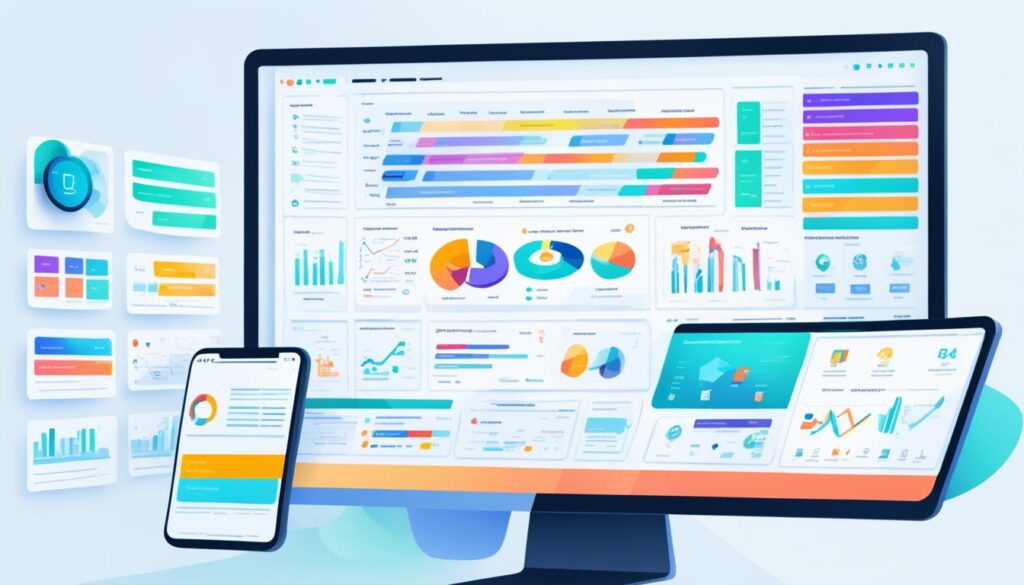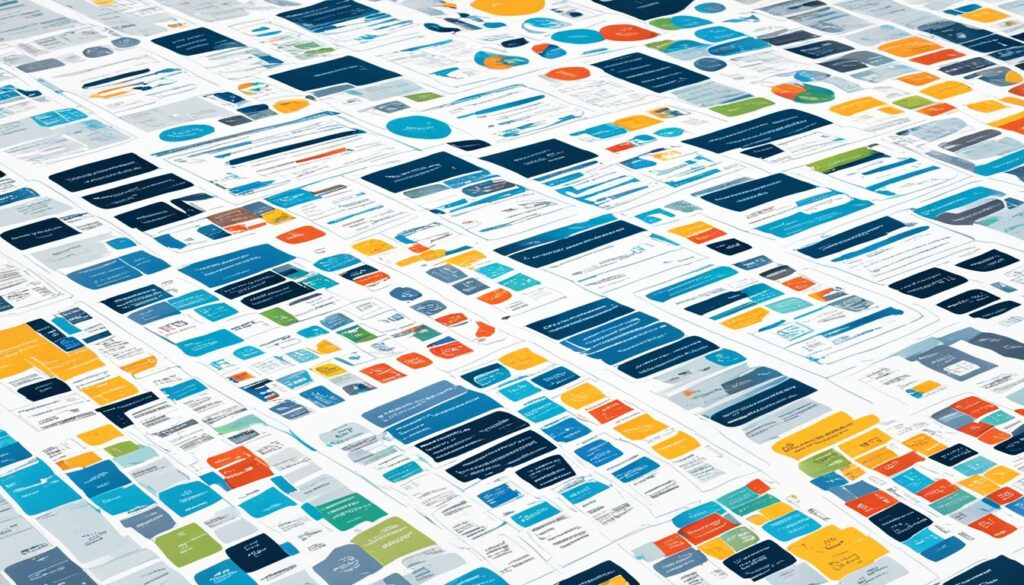The digital world is always changing. Because of this, businesses in the United States are improving their software buying strategies. This is to make sure they stay on top. It’s smart and necessary for their growth. Adjusting how they buy software to meet new needs is crucial.
Smart buying strategies give companies an edge. They can quickly adapt to new market changes and predict tech shifts. By managing this well, they can make the most out of their investments. They’ll be able to choose wisely among many options and face any challenges.
Key Takeaways
- In-depth risk management is crucial for the effective software acquisition.
- An adaptable roadmap is key to successful software procurement outcomes.
- Today’s software acquisition management strategies must account for system-of-systems integrations and dynamic market conditions.
- Understanding system interfaces and usage patterns is essential to refine assurance strategies amidst increasing complexity.
- Software purchasing processes that align with business objectives and account for evolving requirements foster organizational resilience.
Understanding the Impact of System-of-Systems on Software Acquisition
In today’s world, technology depends on other technology. A smart software sourcing strategy is key. It helps navigate through the complex Systems-of-Systems (SoS). This is crucial for organizations wanting to stay updated with the ever-changing IT assets. Here, we look into how software buying strategies need to change. They must ensure smooth integration and meet assurance goals within complicated systems.
The Evolution of Acquisition Strategy Development
The way we buy software has changed as SoS have gotten more complex. It has moved from focusing on single systems to tapping into collective capabilities. Now, the approaches focus on how well different systems can work together and adapt over time.
Adapting Acquisition Strategies for Complex Integrations
SoS make integrating technology like trying to solve a puzzle. It requires looking at the big picture. Companies need strategies that deal well with tech surprises. They should also remain flexible to adopt new tech as it comes.
Role of Assurance Goals in Software Acquisition
Assurance goals keep the strategy on track. They make sure the IT asset management process checks quality within the SoS environment. These goals are what software plans must achieve. They must meet the needs of many users while dealing with constant changes.
| Challenge | Strategic Adaptation | Outcome |
|---|---|---|
| Compatibility with existing systems | Forethought in software sourcing | Reduced integration issues |
| Communication across SoS | Enhanced standards for interoperability | Mitigated miscommunication risks |
| Uncertainty and change management | Agile and flexible strategies | Future-proofing IT assets |
Software Acquisition Management: A Dynamic Process
Software acquisition management has changed. It’s not just a simple task anymore. It’s a moving process that takes into account many factors. These include both present and upcoming needs. Today, having a flexible and smart strategy is crucial for success. This approach helps companies meet their immediate and future software needs well.

Key Elements of a Robust Acquisition Strategy
Creating a strong software acquisition strategy involves several important steps. Software vendor evaluation is key. It assesses if a vendor can meet the technical needs and offer continued support. Software license management is also vital. It makes sure software is used legally and ensures investments are worthwhile. A great strategy also anticipates the software’s growth and how it fits within the broader system.
Aligning Software Requirements with Business Objectives
Effective management of software acquisition means matching software needs with business goals. The chosen software should not only help currents needs but be ready for future changes. By focusing on both software vendor evaluation and software license management, companies can choose software that grows with them. This ensures they get software that is scalable and flexible for the future.
| Software Acquisition Consideration | Business Objective Alignment | Management Strategy Benefit |
|---|---|---|
| Stakeholder Requirements | Reflected in software’s functionality | Meets user expectations and promotes adoption |
| Scheduling and Resource Allocation | Maintaining cost-effectiveness | Ensures on-time delivery within budget |
| Vendor Capability and History | Reliability and support for scaling | Facilitates long-term vendor relationships |
| Performance Expectations | Software upholds performance standards | Drives productivity and efficiency |
| Regulatory Compliance | Mitigates legal and financial risks | Ensures adherence to industry standards |
| License Management | Cost optimization by license control | Prevents over-spending and underutilization |
The Significance of Software Vendor Evaluation in Acquisition Management
When organizations choose software, the software vendor evaluation is key. It affects costs, timelines, and what the software can do. It’s about checking the software and the vendor’s ability to match future needs and fit with the company’s goals.

Today, with security risks growing, teams look for procurement software tools that can change quickly. Tools that can handle new threats as they appear. This approach ensures software stays strong over time, which is vital for keeping it useful in the long run.
In software license management, checking vendors carefully helps avoid legal or money issues. Understanding license terms helps companies use software right and save money.
| Evaluation Criteria | Vendor A | Vendor B |
|---|---|---|
| Compliance with Industry Standards | ISO 27001 Certified | Not Certified |
| Scalability | Modular Architecture | Fixed Features |
| Support and Maintenance | 24/7 Support Available | Business Hours Only |
| License Flexibility | Flexible Licensing Models | One-size-fits-all Approach |
| Security Features | Advanced Threat Protection | Basic Encryption |
With good software vendor evaluation, leaders can compare vendors on many points like compliance and security. This helps choose the best partners and avoid risks, setting the stage for a better software buying experience.
Establishing a Software Sourcing Strategy for Long-Term Success
A strong software sourcing strategy is crucial for a business’s tech health in the long run. Knowing where to get software and managing it well is key. This ensures success and effectiveness.
Procurement Software Tools and Their Influence on Sourcing
Advanced procurement tools have changed IT buying for the better. They help businesses navigate the fast-paced world of software sourcing. Features like automated vendor comparison and cost analysis make procuring software easier.
Integrating IT Asset Management with Software Procurement
Mixing IT asset management with procurement boosts business performance. This approach views each software purchase as an investment, not just a cost. It helps avoid issues like compliance trouble, spending too much, and buying unnecessary software.
| Procurement Phase | Role of IT Asset Management | Tools & Strategies |
|---|---|---|
| Pre-Purchase Analysis | Tracks and reviews current assets for gaps or redundancies, reducing unnecessary purchases. | Inventory management tools, spend analysis software |
| Vendor Selection | Ensures that software vendors comply with established IT asset criteria and policies. | Vendor management systems, integrated sourcing solutions |
| Negotiation & Purchase | Aligns software licenses with corporate asset frameworks to avoid legal issues. | License management platforms, contract negotiation tools |
| Post-Purchase Management | Continuously monitors and evaluates software to ensure its contribution to business objectives. | Asset tracking systems, performance analytics tools |
Incorporating Best Practices in Software License Management
In the IT world, managing software license management is key. It’s more than just following rules. Top companies know that using this smartly means they save money, stay legal, and work more efficiently. So, how do teams put these best practices into play?
Let’s go through what makes software license management work well:
- Comprehensive Inventory Tracking: First, know what software licenses you own. Use a system to keep a current list. This list should include what the licenses allow, their limits, and when they end.
- Usage Monitoring & Optimization: Always check if your current software licenses match what you really need. If there are licenses you don’t use much, you might want to give them up or use them elsewhere.
- Risk Management: Keep software use legal to avoid legal trouble or fines. You need good auditing tools for this job.
By doing these things, making choices about renewing or buying software makes more sense. You won’t waste money on software you don’t need.
Good software license management is vital. It keeps you legal and saves money. It also helps your company quickly adapt to new tech.
It’s also important to teach your team about using software the right way. When they understand, they can help keep everything legal and clear. Having strict rules for buying and using software makes software license management smooth. This shows your team is serious and committed to being their best.
Mixing software license management with IT asset management is a smart move. It makes the benefits even bigger. This helps see how much you spend on IT clearer. It also makes planning your future IT needs easier.
In sum, prioritizing software license management is a smart investment. It turns software from just a tool into a valuable asset. This approach is not only about following the law. It’s about staying ahead in today’s tech-driven business scene.
Mitigating Risks Through Effective IT Procurement Processes
An efficient IT procurement process is key for minimizing risk and getting the best results from software purchasing. It involves a deep look at what capabilities are needed and how they may change. This way, it acts as a strategic shield against unexpected problems.
It’s critical to spot and handle risks early on in the procurement cycle. Choosing a lifecycle model that can adapt to changes and cope with uncertainty is essential. Systems engineering and program management are important too. They give a full view of risks in buying complex IT systems.
| IT Procurement Phase | Risk Management Actions |
|---|---|
| Requirement Gathering | Involve stakeholders to ensure comprehensive understanding of needs and constraints. |
| Market Analysis | Evaluate and compare vendors and technologies for best fit. |
| Vendor Negotiation | Conduct negotiations with identified risks and mitigation strategies in mind. |
| Contract Finalization | Ensure clear terms are outlined for requirements, deliverables, and contingencies. |
| Post-Purchase Evaluation | Review and measure performance against expected outcomes and risk baselines. |
The IT procurement process is an ongoing effort. It requires constant updates as new risks appear or as goals change. Being proactive in the software purchasing process lets organizations stay flexible. This ensures they can keep up with current tech and grow in the future.
Leveraging Procurement Software Tools for Enhanced Acquisition Efficiency
In today’s fast-changing tech world, procurement software tools are key for improving the software acquisition management process. They offer many functions that help in market analysis, finding the best deals, and making sure due diligence is done thoroughly. Given the wide range of software choices and complex agreements, these tools have become essential for firms wanting to enhance their procurement approach.
Getting software efficiently isn’t just about lowering costs. It’s about understanding market trends, how software can work with your existing systems, and making sure it meets your business objectives. Acquisition Managers use these advanced software tools to carry out their work with great accuracy. They can also tap into robust analytics for valuable insights and ensure they follow all regulatory rules. Plus, these tools help teams work together better, making decisions more unified and improving how systems with many parts and people work together.
For Acquisition Managers, constantly learning and engaging with peers is vital. Keeping up with new software tools and sharing know-how in forums can lead to better practices. This boosts an organization’s ability to buy software wisely. Thus, by mastering these tools, professionals can use strategic insights more effectively. This keeps them ahead in the competitive software procurement field, leading to better results.



